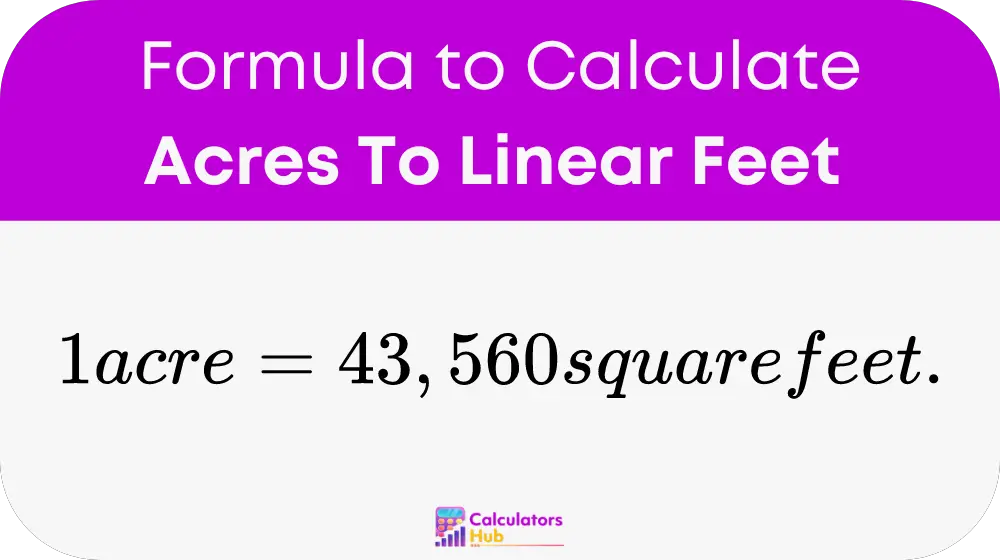The Acres To Linear Feet Calculator is a specialized tool designed to convert land area measured in acres into linear feet. This conversion is essential for several reasons:
- Practical Understanding: Linear feet are a more commonly understood unit of measurement for distances, making it easier to comprehend the dimensions of land.
- Real Estate Transactions: Accurate conversion helps in the buying, selling, and registration of land by providing precise measurements in commonly used units.
- Land Management: It aids in planning and executing land usage strategies by ensuring accurate area and length measurement.
Whether you are a real estate agent, a farmer, or a landowner, the Acres To Linear Feet Calculator provides valuable insights into your land area and dimensions, helping you manage resources more effectively and efficiently.
Formula of Acres To Linear Feet Calculator
To convert an area from acres to linear feet, you can use the following detailed formula:

To find the length in linear feet (L) for a given area in acres, you need to know the width (W) in feet. The formula is as follows:
Acres * 43,560 = L * W
Rearranging the formula to solve for L (length in linear feet):
L = (Acres * 43,560) / W
Steps:
- Take the area in acres.
- Determine the width in feet.
- Multiply the area in acres by 43,560.
- Divide the result by the width in feet.
This formula provides a simple and accurate method for converting acres to linear feet, making it easier to understand and manage land measurements.
Conversion Table
For quick reference, here is a table with pre-calculated conversions for common acre values. This table can save time and effort by providing immediate answers for frequently needed conversions:
| Acres | Width (feet) | Length (linear feet) |
|---|---|---|
| 1 | 10 | 4,356 |
| 1 | 20 | 2,178 |
| 1 | 50 | 871.2 |
| 1 | 100 | 435.6 |
| 2 | 10 | 8,712 |
| 2 | 20 | 4,356 |
| 2 | 50 | 1,742.4 |
| 2 | 100 | 871.2 |
This table provides a ready reference for converting up to 2 acres into linear feet for various widths, making it convenient for quick calculations without needing to perform the multiplication each time.
Example of Acres To Linear Feet Calculator
Let’s consider a practical example where we need to convert 3 acres to linear feet with a width of 50 feet. This example will illustrate how the formula is applied in a real-world scenario:
- Identify the area in acres: In this case, we need to convert 3 acres.
- Determine the width in feet: The width is 50 feet.
- Multiply the area in acres by 43,560: 3×43560=130680
- Divide the result by the width in feet: 130680/50=2613.6
Therefore, 3 acres with a width of 50 feet equal 2613.6 linear feet.
This example demonstrates the simplicity and accuracy of the Acres To Linear Feet Calculator, making it a valuable tool for anyone involved in land management.
Most Common FAQs
A linear foot is a unit of measurement equal to 12 inches or 1 foot. It is commonly used to measure length or distance in a straight line.
Converting acres to linear feet makes it easier to understand and manage the dimensions of a piece of land. Linear feet provide a more intuitive understanding of distances and lengths.
The Acres To Linear Feet Calculator is highly accurate, using the precise conversion factor of 43,560 square feet per acre. This ensures reliable results for practical applications, whether you are planning land use, estimating distances, or managing resources.
By providing an accurate conversion from acres to linear feet, the calculator helps in understanding the exact dimensions of land. This knowledge promotes efficient land use planning, reducing errors and supporting effective land management practices.